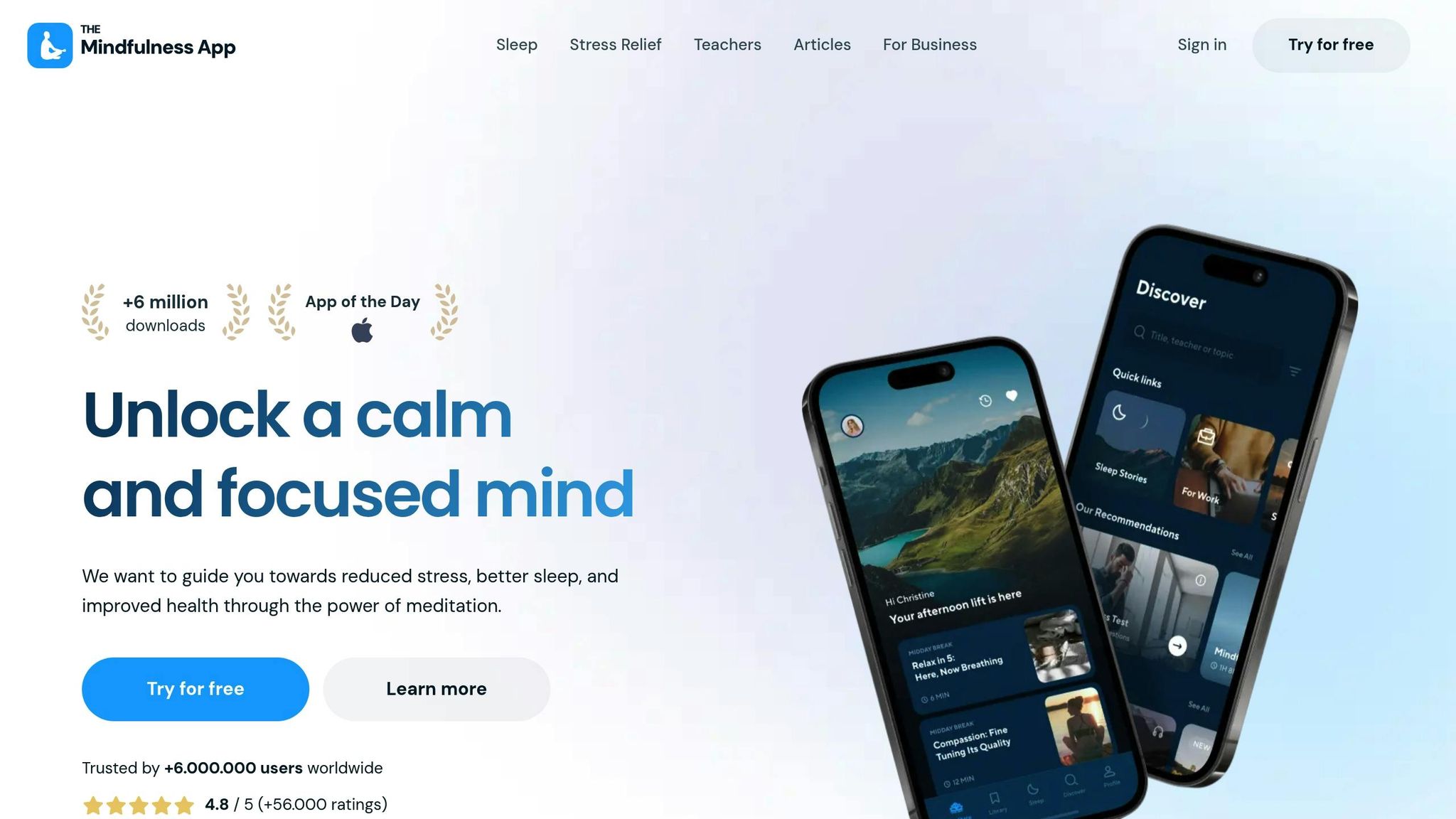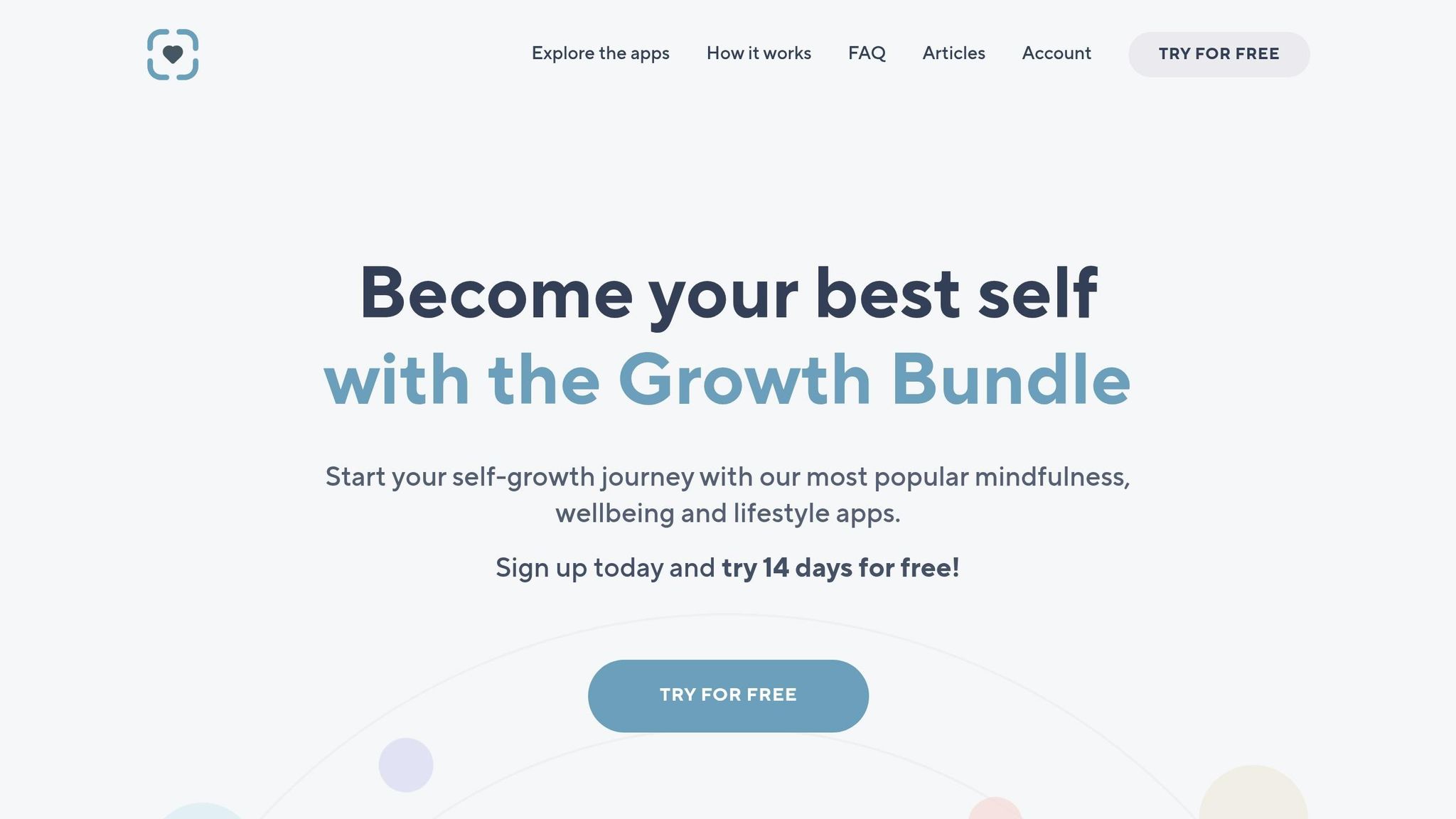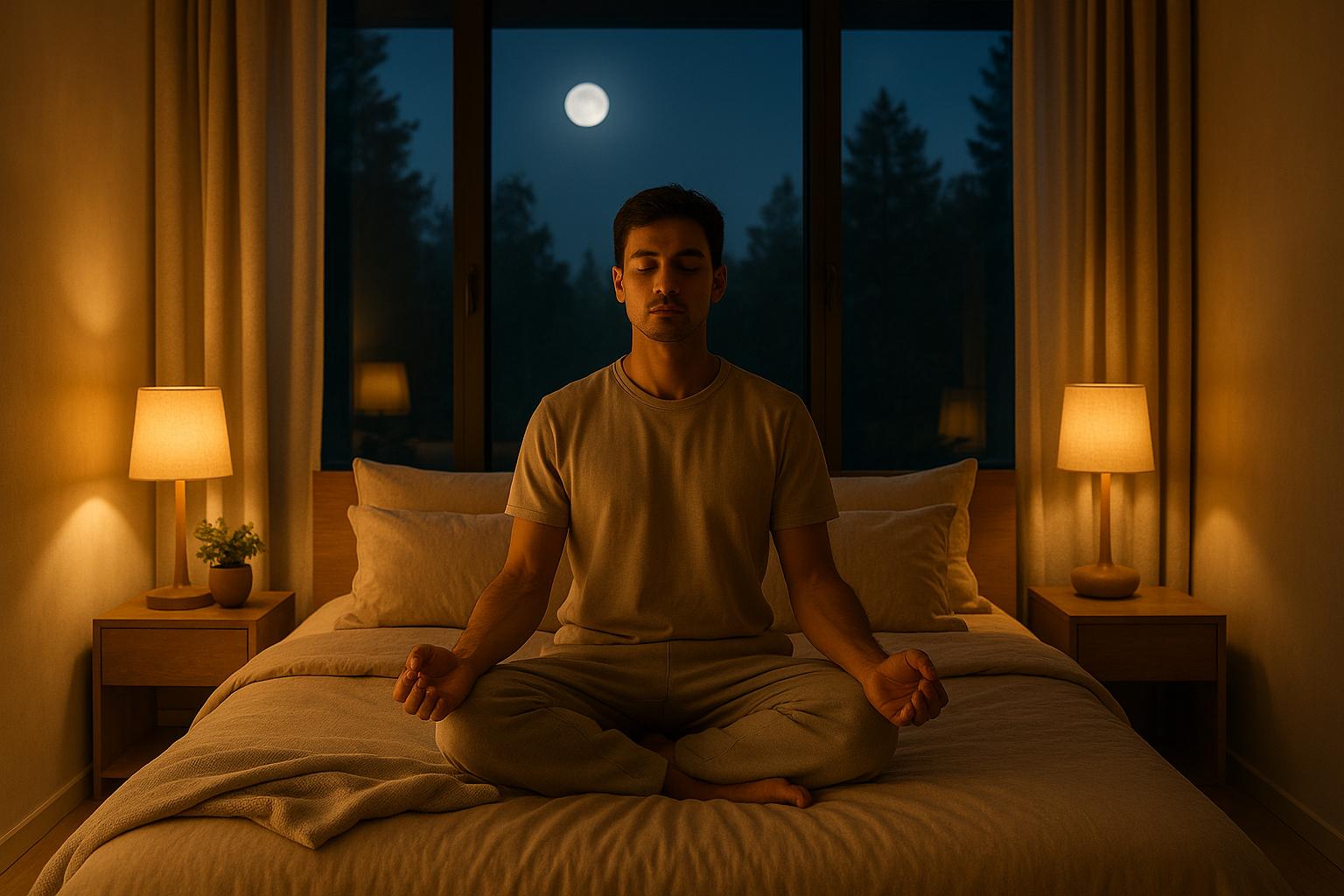To live longer and healthier, focus on two key habits: meditation and quality sleep. Together, they improve mental clarity, emotional balance, and physical repair. Research shows that regular meditation can slow aging by preserving telomeres, while better sleep can add years to your life. Digital tools like meditation apps and sleep trackers make it easier to build these habits into your routine.
- Meditation Benefits: Reduces stress, improves memory, and supports brain health. Short, consistent sessions (2–5 minutes) are effective.
- Sleep Optimization: Consistent schedules, calming routines, and a sleep-friendly environment improve sleep quality.
- Digital Tools: Apps like The Mindfulness App and HealthView help track progress and stay consistent.
Dr. Matt Walker: Protocols to Improve Your Sleep | Huberman Lab Guest Series

Core Meditation Practices for Longevity
When it comes to meditation for longevity, consistency beats marathon sessions. Short, regular practices can deliver powerful benefits for healthy aging. The secret lies in choosing techniques that align with your wellness goals.
Mindfulness and Breathwork Techniques
Mindfulness and breathwork are at the heart of meditation practices that support longevity. Jon Kabat-Zinn, the creator of Mindfulness-Based Stress Reduction (MBSR), describes mindfulness as:
"Awareness that arises through paying attention, on purpose, in the present moment, non-judgmentally, and then I sometimes add, in the service of self-understanding and wisdom."
The science backs this up. Studies reveal that regular meditators at age 50 have brains that appear 7.5 years younger than non-meditators, and they also tend to have telomeres - key markers of cellular aging - that are about 10% longer.
Breathwork complements mindfulness by reducing stress and promoting relaxation. As Alistair Hawkes, a Licensed Professional Counselor and Certified Clarity Breathwork Practitioner, puts it:
"Breath work is the foundation for stress management."
Research shows that slow, deep breathing can ease anxiety and increase comfort in just a few minutes. A meta-analysis of randomized controlled trials also found breathwork significantly reduces stress and improves mental health.
Other techniques like Transcendental Meditation (TM), which uses a repeated mantra to achieve deep relaxation, have been shown to reduce stress and support cellular health. Compassion meditation, or loving-kindness meditation, adds another layer by fostering empathy and reducing inflammation markers.
Even short daily sessions - just 2 to 5 minutes - can reduce stress and sharpen focus.
Using The Mindfulness App for Daily Practice

For those looking to incorporate meditation into their busy lives, The Mindfulness App offers a modern solution. Available through Growth Bundle, this app simplifies meditation by providing guided sessions tailored to your goals. It’s especially helpful for beginners or anyone struggling to stay consistent.
Research shows that mindfulness apps can reduce mind-wandering, boost positive emotions, and enhance kindness. Users often report lower levels of depression and aggression after just a few weeks of app-based practice.
The app organizes meditations by themes like stress relief, gratitude, relationships, and compassion - key areas that influence aging. Progress tracking features let you monitor your consistency and see how your practice evolves over time.
Guided meditations take the guesswork out of the equation, offering structured sessions that teach proper techniques while keeping you engaged. The app also explains the science behind each practice, helping you connect your daily efforts to long-term health benefits.
Adding Meditation to Everyday Routines
The best way to maintain a meditation habit is to weave it into your daily life. Instead of treating it as a separate task, integrate mindfulness into activities you already do.
Morning meditation is a great starting point. Research shows that meditating at the same time each day helps establish a routine. Begin with a quick 2–5 minute session right after waking, or practice mindful breathing during your commute - whether on public transportation or at red lights. Even these small moments can reduce stress.
At work, brief mindfulness exercises can help counteract stress. For example, the 5-4-3-2-1 technique asks you to identify five things you can see, four you can touch, three you can hear, two you can smell, and one you can taste. Taking a few mindful breaths before meetings can also provide a steadying effect throughout the day.
An evening meditation session, lasting 5–10 minutes before bed, can help you unwind and transition into a restful sleep state. This practice supports a more restorative sleep cycle, which is essential for overall health.
You can also bring mindfulness into everyday activities. Try mindful walking during lunch breaks, savor your meals with mindful eating, or focus on your breath while doing household chores.
As Thich Nhat Hanh beautifully said:
"People usually consider walking on water or in thin air a miracle. But I think the real miracle is not to walk either on water or in thin air, but to walk on earth."
Starting small is key. Begin with just 2–5 minute sessions and gradually increase as it becomes part of your routine. Remember, meditation isn’t about completely clearing your mind - it’s about noticing distractions and gently bringing your focus back to the present. Over time, this practice strengthens your mindfulness and contributes to the longevity benefits you’re working toward.
These practices lay the foundation for improving another critical area of wellness: sleep, which we’ll explore next.
Sleep Optimization Strategies and Tools
Getting quality sleep is just as crucial as meditation when it comes to living a long and healthy life. While meditation calms the mind, sleep repairs the body. Together, they form a solid foundation for aging well.
Building a Consistent Sleep Routine
When it comes to sleep, consistency matters just as much as duration. A regular sleep schedule can lower overall mortality risk by up to 30% and reduce cardiometabolic risks by 38%.
Dr. Raj Dasgupta, an associate professor at the University of Southern California's Keck School of Medicine, highlights this:
"We're talking about not just quality and quantity of sleep, but regularity, getting the same good sleep night after night."
Setting Your Sleep Schedule
To establish a routine, start by working backward from your wake-up time to ensure you get 7–9 hours of sleep. For instance, if you wake up at 6:00 AM, aim for a bedtime between 9:00 PM and 11:00 PM. Adjust gradually in 15–20-minute increments until you find the right balance.
Julia Kogan, a health psychologist at the Department of Veterans Affairs, explains:
"By waking up at a consistent time every day, it helps set our body's clock, known as the circadian rhythm, which also helps us feel sleepy at the same time every day and have a sufficient window of time for sleep."
Creating Your Sleep Environment
Your bedroom should be a sanctuary for rest. Keep the temperature between 65°F and 68°F, block out light and noise, and upgrade any uncomfortable bedding. A cooler room helps your body naturally prepare for sleep by lowering its temperature.
Use blackout curtains, eye masks, earplugs, or a white noise machine to minimize distractions. Exposure to natural morning light can also help regulate your circadian rhythm.
Establishing a Wind-Down Routine
Dedicate the hour before bed to relaxing, screen-free activities like reading, meditating, or taking a warm bath. Avoid stimulants like caffeine, alcohol, and nicotine for several hours before bedtime. Keep your evening meal light and finish eating at least 1–2 hours before going to bed.
These habits not only improve sleep quality but also set the stage for tracking and refining your sleep patterns.
Tracking and Analyzing Sleep Patterns
Once you’ve established a bedtime routine, tracking your sleep can help you fine-tune your approach. Sleep tracking apps provide insights into your sleep duration, quality, and any disruptions. They collect data like heart rate, bedtime, and wake time to give you a clearer picture of your sleep habits.
Key Metrics to Monitor
Track metrics such as how long you sleep, the time spent in different sleep stages (light, deep, and REM), heart rate changes, and how often you wake up during the night. Other useful indicators include sleep onset latency (how quickly you fall asleep) and wake after sleep onset (time spent awake after initially falling asleep).
Using HealthView for Sleep Analysis
HealthView, part of the Growth Bundle, makes it easy to track your sleep alongside other health data. The app syncs with Apple Health and works with Apple Watch, allowing you to monitor your progress, set goals, and share data with your healthcare provider for personalized advice.
A 2019 study even found that some sleep apps can detect sleep-wake stages and breathing issues with accuracy comparable to clinical studies.
Analyzing Your Data
Focus on trends over weeks rather than individual nights. Look for patterns related to factors like caffeine, exercise, screen time, and stress. Keeping a sleep diary can also help - note details like room temperature, noise levels, and evening habits to identify areas for improvement.
Relaxation Aids and Smart Alarms
The right tools can make falling asleep easier and waking up more pleasant. Smart alarms and relaxation aids can work together to enhance your sleep cycle.
Smart Alarm Features
Growth Bundle's Sleep Timer – Smart Alarm wakes you during lighter sleep phases, helping you feel more refreshed compared to traditional alarms that might wake you during deep sleep [website].
Sunrise Simulation and Sound Features
Many smart alarms offer sunrise simulation, gradually brightening your room to mimic natural sunlight and support your circadian rhythm. For example, the Philips SmartSleep Wake-up Light, priced at $108.95, is designed to make waking up gentler. Sound machines like the Yogasleep Duet Sound Machine, available for $45, provide calming soundscapes to help you drift off and stay asleep.
Integration with Your Routine
Combine tools for a seamless sleep experience. Use a smart alarm’s sunset feature to dim lights in the evening and its sunrise simulation to wake up naturally. Pair these with smart home devices to automate tasks like adjusting the thermostat or turning on white noise machines.
Building Your Longevity Stack with Growth Bundle Apps

Creating a longevity stack doesn’t have to be complicated. Growth Bundle simplifies the process by offering a curated collection of 12 apps under one subscription. These tools are designed to help you build habits that enhance meditation and improve sleep. With an impressive average rating of 4.6 stars from over 190,000 reviews, it’s clear that users are seeing real benefits.
Step-by-Step Guide to Combining Tools
Growth Bundle makes it easy to get started with a 14-day free trial, giving you the chance to explore and identify which apps fit seamlessly into your daily life.
Getting Started
To begin, sign up for the free trial, download the recommended apps, and log in with your Growth Bundle account. This single login grants you access to the entire suite across all your devices - whether you’re using a phone, tablet, or desktop. Switching between devices is smooth and hassle-free.
Key Apps for Building Your Longevity Stack
- The Mindfulness App: This is your go-to for meditation, offering over 500 meditations, sleep stories, courses, and podcasts to keep your practice fresh and engaging.
- HealthView: Syncs with Apple Health and Apple Watch to monitor key metrics like sleep patterns and heart rate, giving you deeper insights into your wellness.
- The Do App: Helps you set daily goals, track progress, and build consistent habits. With a 4.0 rating from over 16,600 users, it’s a proven tool for staying on track.
Once you’ve selected the apps that suit your goals, the next step is to integrate them into a daily routine.
Structuring Your Daily Routine
Kick off your day with a meditation session using The Mindfulness App. Afterward, log your sleep data in HealthView to track how well you rested. Throughout the day, use the Do App to monitor habits like drinking enough water, taking breaks, or reducing screen time in the evening. As bedtime approaches, return to The Mindfulness App for a sleep story or a calming relaxation exercise.
Using Reflectly for Stress Management

For tackling stress, Reflectly offers an AI-powered journaling experience that helps you track your emotions and identify patterns that influence your mood. Available on both iOS and Android, the app becomes more tailored to your needs the more you use it, offering insights that grow increasingly relevant.
Here’s how to incorporate Reflectly into your evening: after tracking your habits in the Do App, spend 5–10 minutes journaling about your day. This reflective practice can help clear your mind and guide your meditation choices. For example, if you notice heightened stress on certain days, you might choose a longer or more targeted meditation session using The Mindfulness App.
Synchronizing Your Routine with Growth Bundle
Once you’ve established a stress management routine, you’ll see how seamlessly all the tools in Growth Bundle work together. For $99.99 per year, you gain access to the entire suite - a more cost-effective solution compared to managing multiple individual subscriptions.
Growth Bundle streamlines the process of building lasting wellness habits by eliminating the hassle of juggling separate apps and logins. Each app serves a specific role, whether it’s meditation, habit tracking, or health monitoring.
What Users Are Saying
Real user feedback highlights Growth Bundle’s thoughtful design and responsive support, which are reflected in updated 5-star reviews.
Tailoring the Tools to Your Needs
Growth Bundle also provides personalized recommendations to help you find the apps that align with your specific goals. Whether you’re focused on meditation, improving sleep, or tracking your overall health, you can customize your longevity stack to suit your priorities. This integrated approach helps you stay on track toward better wellness.
The key is consistency. Start small - choose one or two apps to focus on, build those habits, and then gradually add more tools as your routine becomes second nature.
sbb-itb-72d195f
Maintaining and Improving Your Longevity Stack
Building your longevity stack is just the beginning; keeping it effective requires consistent effort and adaptability. Research suggests that showing up regularly and varying your approach matters more than how long each session lasts. In other words, focus on creating a sustainable routine rather than aiming for perfection every time. Let’s explore how to weave these tools into your daily habits.
Forming Habits That Stick
Tying new habits to existing routines can make them second nature. For example, studies show that linking meditation to a daily task, like brushing your teeth, can create a habit that feels automatic over time. Growth Bundle's apps are designed to seamlessly integrate into your day-to-day life.
Start with The Do App to track simple habits like morning meditation or evening journaling. Its visual streaks keep you motivated. Pair it with Timebloc to carve out specific time slots for these practices. Research backs this strategy: participants who anchored meditation to a fixed routine were more likely to stick with it daily (1.14 odds ratio). Those who tied their practice to morning routines also maintained their habits better over an 8-week period (1.13 odds ratio).
Here’s a practical example: after brushing your teeth, open The Mindfulness App for a quick 5–10 minute session. Once done, log your meditation in The Do App and use Timebloc to plan your day. This sequence becomes a natural part of your routine over time.
Adapting to Your Goals and Progress
Your longevity stack should evolve alongside your personal goals and the data you collect. This is where HealthView comes in, syncing with Apple Health and Apple Watch to monitor metrics like sleep quality and heart rate variability. Reviewing this data weekly can reveal trends and guide adjustments.
If you notice a drop in sleep quality despite sticking to a bedtime routine, consider experimenting with different meditation techniques in The Mindfulness App. Research shows that mixing up your practices - like alternating between mindfulness meditation, body scans, and sleep stories - can lead to better overall outcomes.
For emotional insights, Reflectly uses AI-powered journaling to highlight patterns in your mood and stress levels. For instance, if you notice anxiety spikes on certain days, you might extend your meditation sessions or try stress-reduction methods tailored to those moments.
Keep in mind that longer meditation sessions (21–30 minutes) are great for improving mood and resilience, while shorter ones (11–20 minutes) are better for recovery. Use this knowledge to fine-tune your practice based on what you need most - whether it’s a mood boost or stress relief.
Monthly reviews can help you stay on track. Check your meditation streaks in The Do App, analyze sleep trends in HealthView, and reflect on emotional patterns in Reflectly. Regularly updating your routine based on this data ensures it stays aligned with your goals.
Staying Engaged with App Updates
Frequent updates to Growth Bundle's apps play a big role in keeping users engaged. Apps that are regularly updated see much higher retention rates - up to four times more than those with infrequent updates. New features, like added meditation courses or improved analytics in HealthView, keep your routine fresh and exciting.
Virtual mindfulness tools are also proving to be as effective as traditional treatments for issues like sleep disturbances. As these apps evolve with new research and features, your longevity stack becomes even more effective.
To stay motivated, consider setting quarterly goals that align with app updates. For instance, if The Mindfulness App releases a new sleep program, focus on incorporating it into your routine over the next few months. Consistency is key in mindfulness training, and regular practice is essential for improving overall well-being.
"Long-term real-world digital meditation practice is effective and associated with improvements in mood, equanimity, and resilience. Practice consistency and variety rather than length best predict improvement. Long-term sustainable practices are best predicted by consistency, a morning routine, and a practice balanced across objects of focus that are internal and external to the body."
– Micah Cearns, Insight Timer Research, Insight Timer
With your Growth Bundle subscription, you have everything you need to maintain and refine your longevity stack. By combining consistency, data-driven adjustments, and evolving tools, you can ensure your wellness routine supports your goals for the long haul - all without juggling multiple subscriptions.
Conclusion: Achieving Longevity Through Meditation and Sleep
Living longer and healthier often boils down to the right combination of habits. Meditation and sleep optimization are two practices that, when paired, create a powerful partnership. Meditation helps improve the quality of your sleep, while better sleep enhances the benefits of meditation. Together, they form a cycle of wellness that not only boosts how you feel each day but also supports long-term health. This connection isn’t just anecdotal - research backs it up with compelling evidence.
Studies show that advanced meditators have brains that appear about 5.9 years younger than their actual age. On the other hand, adopting five solid sleep habits can extend life expectancy by nearly five years for men and 2.5 years for women. When combined, these practices act like an anti-aging toolkit for both your body and mind.
"Deep rest is something our bodies need and deserve. With it, we improve our chances for healthy longevity." - Elissa Epel, PhD, professor of psychiatry and vice chair of psychology
The challenge, however, lies in consistency. Many people know the benefits of meditation and quality sleep but struggle to maintain these habits. For instance, over 40% of Americans sleep less than 7 hours a night, and fewer than 1% practice mindfulness regularly. This is where Growth Bundle steps in, offering a streamlined solution. Instead of juggling multiple apps that don’t sync, Growth Bundle integrates everything into one cohesive system, making it easier to stay on track.
Growth Bundle’s tools are designed to simplify habit-building. They take the guesswork out of wellness by offering actionable insights. For example, HealthView can show how regular meditation improves your heart rate variability, while Reflectly helps you identify links between stress and sleep quality. This isn’t just about tracking progress - it’s about using real data from your body to refine your approach.
Meditation’s ability to boost sleep efficiency also plays a key role in protecting your brain from aging. By sticking to a consistent sleep schedule and meditating daily with Growth Bundle’s tools, you’re doing more than improving how you feel today - you’re safeguarding your cognitive health for the future.
Ultimately, achieving longevity isn’t about perfection; it’s about persistence and having the right tools at your disposal. Growth Bundle’s suite of apps provides everything you need to build and sustain these life-enhancing habits. The science is clear: meditation and sleep can improve both lifespan and healthspan. The real question is, are you ready to make consistency your secret weapon and use technology to support your journey toward living longer and better?
FAQs
What’s the best way to combine meditation and sleep optimization for better health and longevity?
To effectively blend meditation with better sleep habits, start by incorporating daily meditation into your routine. This could be mindfulness exercises or guided sessions - many people find that meditating in the evening helps them unwind. Pair this with a consistent sleep schedule, aiming to go to bed and wake up at the same time every day.
Introduce a calming pre-bedtime ritual to signal your body it's time to rest. This might include activities like reading, gentle stretching, or practicing deep breathing. You can also use sleep tracking apps to keep an eye on your sleep patterns and pinpoint areas to adjust. Lastly, make sure your bedroom is set up for restful sleep - keep it cool, dark, and quiet. By weaving these strategies into your daily life, you'll likely experience less stress, better sleep, and an overall boost to your health.
How do Growth Bundle apps support better meditation and sleep habits?
The Growth Bundle apps are crafted to elevate your meditation and sleep habits with a range of helpful tools. They offer guided meditation sessions, soothing sleep stories, tranquil soundscapes, and breathing exercises designed to help you relax and center yourself. Additionally, you’ll have access to habit tracking tools and personalized meditation programs that align with your specific goals, making it simpler to establish and stick to wellness routines. Together, these features aim to support your overall well-being and long-term health journey.
How do meditation and better sleep work together to improve brain health and slow aging?
How Meditation and Quality Sleep Work Together for Brain Health
Meditation and good sleep go hand in hand, creating a powerful duo for brain health and slowing down the aging process. Regular meditation helps to ease stress by lowering cortisol levels - something crucial since high cortisol can harm the brain over time. Plus, meditation encourages relaxation and mindfulness, helping to quiet the mind, making it easier to drift off to sleep.
On the flip side, quality sleep plays a vital role in brain health. It’s during sleep that the brain repairs itself, strengthens memory, and supports cognitive function. When you combine meditation with restful sleep, the benefits multiply. This combination helps protect brain structure, sustain mental sharpness, and lowers the risk of age-related cognitive decline. Together, they lay the groundwork for lasting mental and physical health.
